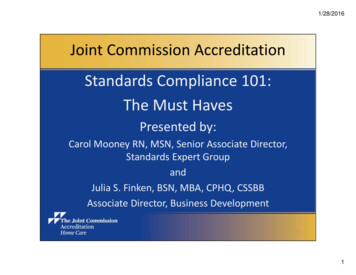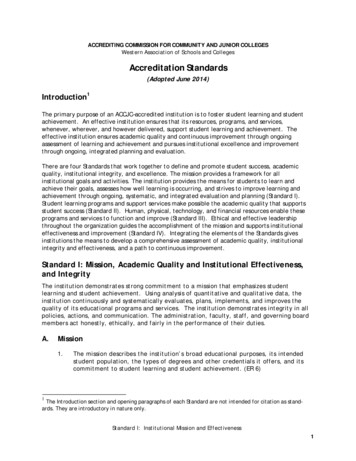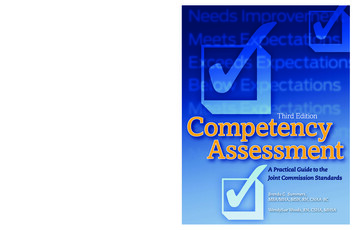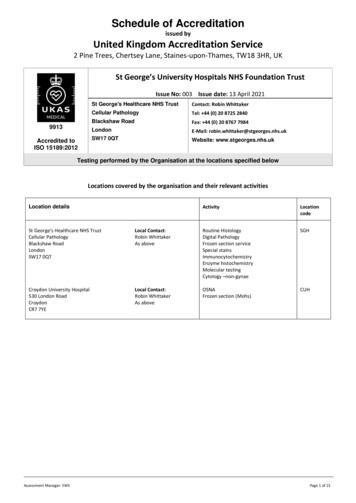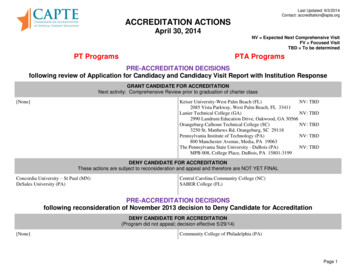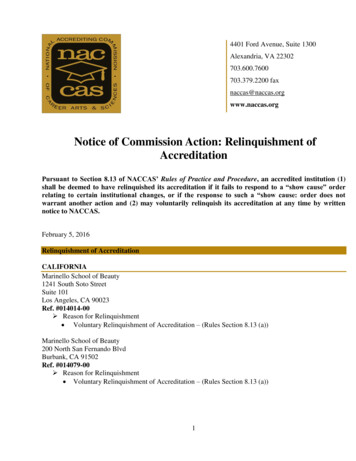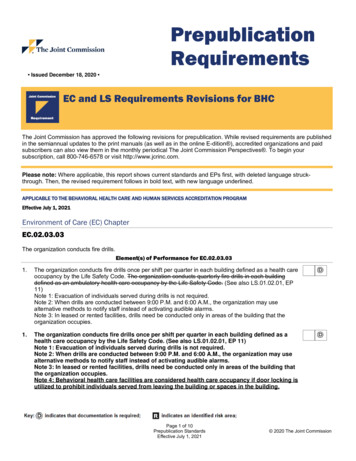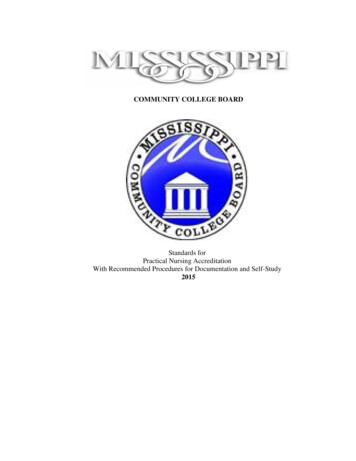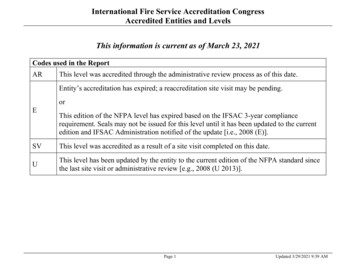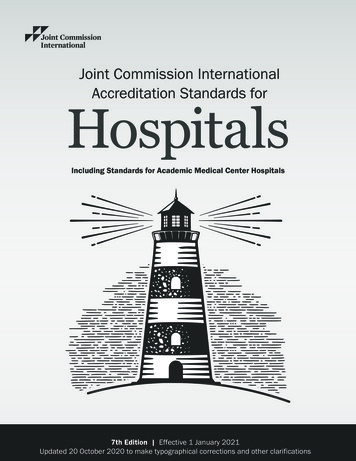
Transcription
Joint Commission InternationalAccreditation Standards forHospitalsIncluding Standards for Academic Medical Center Hospitals7th Edition Effective 1 January 2021Updated 20 October 2020 to make typographical corrections and other clarifications
Section I:Accreditation ParticipationRequirements
AccreditationParticipationRequirements (APR)Requirement APR.1The hospital meets all requirements for timely submissions of data and information to Joint CommissionInternational (JCI).Requirement APR.2The hospital provides JCI with accurate and complete information throughout all phases of the accreditationprocess.Requirement APR.3The hospital reports within 30 days of the effective date of any change(s) in the hospital’s profile (electronicdatabase) or information provided to JCI via the E-App before and between surveys.Requirement APR.4The hospital permits on-site evaluations of standards and policy compliance or verification of quality and safetyconcerns, reports, or regulatory authority sanctions at the discretion of JCI.Requirement APR.5The hospital allows JCI to request (from the hospital or outside agency) and review an original or authenticatedcopy of the results and reports of external evaluations from publicly recognized bodies.Requirement APR.6Currently not in effect.Requirement APR.7The hospital selects and uses measures as part of its quality improvement measurement system.3
Joint Commission International Accreditation Standards for Hospitals, 7th EditionRequirement APR.8The hospital accurately represents its accreditation status and the programs and services to which JCIaccreditation applies. Only hospitals with current JCI accreditation may display the Gold Seal.Requirement APR.9Any individual hospital staff member (clinical or administrative) can report concerns about patient safety andquality of care to JCI without retaliatory action from the hospital.To support this culture of safety, the hospital must communicate to staff that such reporting is permitted. Inaddition, the hospital must make it clear to staff that no formal disciplinary actions (for example, demotions,reassignments, or change in working conditions or hours) or informal punitive actions (for example,harassment, isolation, or abuse) will be threatened or carried out in retaliation for reporting concerns to JCI.(Also see GLD.13 and GLD.13.1)Requirement APR.10Translation and interpretation services arranged by the hospital for an accreditation survey and any relatedactivities are provided by qualified translation and interpretation professionals who have no relationship to thehospital.Qualified translators and interpreters provide to the hospital and JCI documentation of their experience intranslation and interpretation. The documentation may include, but is not limited to, the following:Evidence of advanced education in English and in the language of the host hospital Evidence of translation and interpretation experience, preferably in the medical fieldEvidence of employment as a professional translator or interpreter, preferably full-time Evidence of continuing education in translation and interpretation, preferably in the medical field Membership(s) in professional translation and interpretation associations Translation and interpretation proficiency testing results, when applicable Translation and interpretation certifications, when applicable Other relevant translation and interpretation credentialsIn some cases, JCI can provide organizations with a list of translators and interpreters who meet therequirements listed above.Requirement APR.11The hospital notifies the public it serves about how to contact its hospital management and JCI to reportconcerns about patient safety and quality of care.Methods of notice may include, but are not limited to, distribution of information about JCI, includingcontact information in published materials such as brochures and/or posting this information on the hospital’swebsite.The following link is provided to report a patient safety or quality-of-care concern to tals seeking initial accreditation should be prepared to discuss their plan on how compliance with thisAPR will be achieved when accredited.4
Joint Commission International Accreditation Standards for Hospitals, 7th EditionRequirement APR.12The hospital provides patient care in an environment that poses no risk of an immediate threat to patientsafety, public health, or staff safety.5
Section II:Patient-CenteredStandards
International PatientSafety Goals (IPSG)GoalsGoal 1: Identify Patients CorrectlyIPSG.1The hospital develops and implements a process to improve accuracy of patient identifications. 𝖯Goal 2: Improve Effective CommunicationIPSG.2The hospital develops and implements a process to improve the effectiveness of verbal and/ortelephone communication among caregivers. 𝖯IPSG.2.1The hospital develops and implements a process for reporting critical results ofdiagnostic tests. 𝖯IPSG.2.2The hospital develops and implements a process for handover communication. 𝖯Goal 3: Improve the Safety of High-Alert MedicationsIPSG.3The hospital develops and implements a process to improve the safety of high-alert medications. 𝖯IPSG.3.1The hospital develops and implements a process to improve the safety of look-alike/sound-alike medications. 𝖯IPSG.3.2The hospital develops and implements a process to manage the safe use ofconcentrated electrolytes. 𝖯Goal 4: Ensure Safe SurgeryIPSG.4The hospital develops and implements a process for the preoperative verification and surgical/invasive procedure site marking. 𝖯IPSG.4.1The hospital develops and implements a process for the time-out that is performedimmediately prior to the start of the surgical/invasive procedure and the sign-out thatis conducted after the procedure. 𝖯Goal 5: Reduce the Risk of Health Care–Associated InfectionsIPSG.5The hospital adopts and implements evidence-based hand-hygiene guidelines to reduce the risk ofhealth care–associated infections. 𝖯IPSG.5.1Hospital leaders identify care processes that need improvement and adopt andimplement evidence-based interventions to improve patient outcomes and reduce therisk of hospital-associated infections. 𝖯Goal 6: Reduce the Risk of Patient Harm Resulting from FallsIPSG.6The hospital develops and implements a process to reduce the risk of patient harm resulting fromfalls for the inpatient population. 𝖯7
Joint Commission International Accreditation Standards for Hospitals, 7th EditionIPSG.6.18The hospital develops and implements a process to reduce the risk of patient harmresulting from falls for the outpatient population. 𝖯
Access to Care andContinuity of Care(ACC)StandardsScreening for Admission to the HospitalACC.1Patients who may be admitted to the hospital or who seek outpatient services are screened toidentify if their health care needs match the hospital’s mission and resources, and those withemergent, urgent, or immediate needs are given priority for assessment and treatment. 𝖯ACC.1.1The hospital considers the clinical needs of patients and informs patients when thereare unusual delays for diagnostic and/or treatment services. 𝖯Admission to the HospitalACC.2The hospital has a process for managing the flow of patients throughout the hospital that includesadmitting inpatients and registering outpatients. 𝖯ACC.2.1Patient needs for preventive, palliative, curative, and rehabilitative services areprioritized based on the patient’s condition at the time of admission as an inpatient tothe hospital.ACC.2.2At admission as an inpatient, the patient and family receive education and orientationto the inpatient ward, information on the proposed care and any expected costs forcare, and the expected outcomes of care.ACC.2.3The hospital establishes criteria for admission to and discharge from departments/wards providing intensive or specialized services. 𝖯Continuity of CareACC.3The hospital designs and carries out processes to provide continuity of patient care services in thehospital, coordination among health care practitioners, and access to information related to thepatient’s care. 𝖯ACC.3.1During all phases of inpatient care, there is a qualified individual identified asresponsible for the patient’s care. 𝖯Discharge, Referral, and Follow-UpACC.4The hospital develops and implements a discharge planning and referral process that is based on thepatient’s readiness for discharge. 𝖯ACC.4.1The hospital’s discharge planning process addresses patient and family education andinstruction related to the patient’s ongoing need for continuing care and services.ACC.4.2The complete discharge summary is prepared for all inpatients, and a copy of thedischarge summary is contained in the patient’s medical record.9
Joint Commission International Accreditation Standards for Hospitals, 7th EditionACC.4.2.1 The medical records of patients receiving emergency care includethe time of arrival and departure, the conclusions at termination oftreatment, the patient’s condition at discharge, and follow-up careinstructions.ACC.4.3The records of outpatients requiring complex care or with complex diagnoses containprofiles of the medical care and are made available to health care practitionersproviding care to those patients. 𝖯ACC.4.4The hospital has a process for the management and follow-up of patients who notifyhospital staff that they intend to leave against medical advice. 𝖯ACC.4.4.1 The hospital has a process for the management of patients who leave thehospital against medical advice without notifying hospital staff. 𝖯Transfer of PatientsACC.5The hospital develops a process to transfer patients to other health care organizations based onstatus, the need to meet their continuing care needs, and the ability of the receiving organization tomeet patients’ needs. 𝖯ACC.5.1TransportationACC.610The receiving organization is given a written summary of the patient’s clinicalcondition and the interventions provided by the referring hospital, and the process isdocumented in the patient’s medical record.The hospital’s transportation services comply with relevant laws and regulations and meetrequirements for quality and safe transport. 𝖯
Patient-CenteredCare (PCC)StandardsPatient and Family RightsPCC.1PCC.2PCC.3The hospital is responsible for providing processes that support patients’ and families’ rights duringcare.PCC.1.1The hospital seeks to reduce physical, language, cultural, and other barriers to accessand delivery of services and provides information and education to patients andfamilies in a language and manner they can understand.PCC.1.2The hospital provides care that supports patient dignity, is respectful of the patient’spersonal values and beliefs, and responds to requests for spiritual and religiousobservance.PCC.1.3The hospital establishes a process to ensure patient privacy and confidentiality ofcare and information and allows patients the right to have access to their healthinformation within the context of existing law and culture. 𝖯PCC.1.4The hospital takes measures to protect patients’ possessions from theft or loss.PCC.1.5Patients are protected from physical assault, and populations at risk are identified andprotected from additional vulnerabilities.Patients and families are engaged in all aspects of their medical care and treatment througheducation and participation in care and treatment decisions and care processes. 𝖯PCC.2.1The hospital informs patients and families about their rights and responsibilities torefuse or discontinue treatment, withhold resuscitative services, and forgo or withdrawlife-sustaining treatments. 𝖯PCC.2.2The hospital supports the patient’s right to assessment and management of pain andrespectful compassionate care at the end of life.The hospital measures, analyzes, and—when necessary—improves the patient experience in order toenhance the quality of patient care. 𝖯PCC.3.1The hospital informs patients and families about its process to receive and to act oncomplaints, conflicts, and differences of opinion about patient care and the patient’sright to participate in these processes. 𝖯Patient Consent ProcessPCC.4General consent for treatment, if obtained when a patient is admitted as an inpatient or is registeredfor the first time as an outpatient, is clear in its scope and limits. 𝖯PCC.4.1Patient informed consent is obtained through a process defined by the hospital andcarried out by trained staff in a manner and language the patient can understand. 𝖯11
Joint Commission International Accreditation Standards for Hospitals, 7th EditionPCC.4.2Informed consent is obtained before surgery, anesthesia, procedural sedation, use ofblood and blood products, and other high-risk treatments and procedures. 𝖯PCC.4.3Patients and families receive adequate information about the patient’s condition,proposed treatment(s) or procedure(s), and health care practitioners so that they cangrant consent and make care decisions.PCC.4.4The hospital establishes a process, within the context of existing law and culture, forwhen others can grant consent.Patient and Family EducationPCC.5The hospital provides an education program that is based on its mission, services provided, andpatient population, and health care practitioners collaborate to provide education.PCC.5.1Each patient’s educational needs and ability and willingness to learn are assessed andrecorded in his or her medical record.PCC.5.2Education methods take into account the patient’s and family’s values and preferencesand allow sufficient interaction among the patient, family, and staff for learning tooccur.Organ and Tissue Donation InformationPCC.6The hospital informs patients and families about how to choose to donate organs and other tissues.PCC.6.112The hospital provides oversight for the process of organ and tissue procurement. 𝖯
Assessment ofPatients (AOP)StandardsAOP.1All patients cared for by the hospital have their health care needs identified through an assessmentprocess that has been defined by the hospital. 𝖯AOP.1.1Each patient’s initial assessment includes a physical examination and health history aswell as an evaluation of psychological, spiritual/cultural (as appropriate), social, andeconomic factors.AOP.1.2The patient’s medical and nursing needs are identified from the initial assessments,which are completed and documented in the medical record within the first 24 hoursafter admission as an inpatient or earlier as indicated by the patient’s condition. 𝖯AOP.1.2.1AOP.1.3The initial medical and nursing assessments of emergency patients arebased on their needs and conditions. 𝖯The hospital has a process for accepting initial medical assessments conducted in aphysician’s private office or other outpatient setting prior to admission or outpatientprocedure.AOP.1.3.1A preoperative medical assessment is documented before anesthesiaor surgical treatment and includes the patient’s medical, physical,psychological, social, economic, and discharge needs.AOP.1.4Patients are screened for nutritional status, functional needs, and other special needsand are referred for further assessment and treatment when necessary.AOP.1.5All inpatients, and those outpatients whose condition, diagnosis, or situation mayindicate they are at risk for pain, are screened for pain and assessed when pain ispresent.AOP.1.6Individualized medical and nursing initial assessments are performed for specialpopulations cared for by the hospital. 𝖯AOP.1.7The initial assessment includes determining the need for discharge planning. 𝖯AOP.2All patients are reassessed at intervals based on their condition and treatment to determine theirresponse to treatment and to plan for continued treatment or discharge. 𝖯AOP.3Qualified individuals conduct the assessments and reassessments. 𝖯AOP.4Medical, nursing, and other individuals and services responsible for patient care collaborate toanalyze and integrate patient assessments and prioritize the most urgent/important patient careneeds.13
Joint Commission International Accreditation Standards for Hospitals, 7th EditionLaboratory ServicesAOP.5Laboratory services are available to meet patient needs, and all such services meet applicable localand national standards, laws, and regulations.AOP.5.1A qualified individual(s) is responsible for managing the clinical laboratory serviceor pathology service, and all laboratory staff have the required education, training,qualifications, and experience to administer and perform the tests and interpret theresults. 𝖯AOP.5.2A qualified individual is responsible for the oversight and supervision of the point-ofcare testing program. 𝖯AOP.5.3A laboratory safety program is in place, followed, and documented, and compliancewith the facility management and infection prevention and control programs ismaintained. 𝖯AOP.5.3.1The laboratory uses a coordinated process to reduce the risks ofinfection as a result of exposure to infectious diseases and biohazardousmaterials and waste. 𝖯AOP.5.4Laboratory results are available in a timely way as defined by the hospital. 𝖯AOP.5.5All equipment used for laboratory testing is regularly inspected, maintained, andcalibrated, and appropriate records are maintained for these activities. 𝖯AOP.5.6Essential reagents and supplies are available, and all reagents are evaluated to ensureaccuracy and precision of results. 𝖯AOP.5.7Procedures for collecting, identifying, handling, safely transporting, and disposing ofspecimens are established and implemented. 𝖯AOP.5.8Established norms and ranges are used to interpret and to report clinical laboratoryresults.AOP.5.9Quality control procedures for laboratory services are in place, followed, anddocumented. 𝖯AOP.5.9.1There is a process for proficiency testing of laboratory services. 𝖯AOP.5.10 Reference/contract laboratories used by the hospital are licensed and accredited orcertified by a recognized authority.AOP.5.10.1 The hospital identifies measures for monitoring the quality of theservices to be provided by the reference/contract laboratory.Blood Bank and/or Transfusion ServicesAOP.5.11 A qualified individual(s) is responsible for blood bank and/or transfusion servicesand ensures that services adhere to laws and regulations and recognized standards ofpractice. 𝖯Radiology and Diagnostic Imaging ServicesAOP.6Radiology and diagnostic imaging services are available to meet patient needs, and all such servicesmeet applicable local and national standards, laws, and regulations.AOP.6.114A qualified individual(s) is responsible for managing the radiology and diagnosticimaging services, and individuals with proper qualifications and experience performdiagnostic imaging studies, interpret the results, and report the results. 𝖯
AOP.6.2A radiation and/or diagnostic imaging safety program for patients, staff, and visitors isin place, is followed, and is compliant with applicable professional standards, laws, andregulations. 𝖯AOP.6.3Radiology and diagnostic imaging study results are available in a timely way as definedby the hospital. 𝖯AOP.6.4All equipment used to conduct radiology and diagnostic imaging studies is regularlyinspected, maintained, and calibrated, and appropriate records are maintained forthese activities. 𝖯AOP.6.5Quality control procedures are in place, followed, validated, and documented. 𝖯AOP.6.6The hospital regularly reviews quality control results for all outside contracted sourcesof diagnostic services.15
Care of Patients (COP)StandardsCare Delivery for All PatientsCOP.1Uniform care of all patients is provided and follows applicable laws and regulations. 𝖯COP.2There is a process to integrate and to coordinate the care provided to each patient, and it includes auniform process for prescribing patient orders.COP.2.1Clinical and diagnostic procedures and treatments are carried out and documented asordered, and the results or outcomes are recorded in the pat
ACC.4.1 The hospital’s discharge planning process addresses patient and family education and instruction related to the patient’s ongoing need for continuing care and services. ACC.4.2 The complete discharge summary is prepared for all inpatients, and a copy of the discharge summary is co
